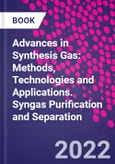Advances in Synthesis Gas: Methods, Technologies and Applications: Syngas Purification and Separation considers different common and novel processes for the purification of produced syngas, such as absorption, adsorption, membrane, cryogenic distillation and particulate separation technologies in addition to thermal and oxidative processes for tar removal. The role of various catalysts or materials in absorption, adsorption and membrane processes are discussed in separate chapters to address each in more detail.
Please Note: This is an On Demand product, delivery may take up to 11 working days after payment has been received.
Table of Contents
Section I: Absorption Techniques for Syngas Purification 1. Characteristics of syngas impurities; physical and chemical properties 2. Syngas purification by common solvents 3. Syngas purification by ionic liquids and DESs 4. Syngas purification by modified solvents with nanoparticles
Section II: Adsorption Techniques for Syngas Purification 5. Swing technologies for syngas purification 6. Metal-oxide sorbents for syngas purification 7. Zeolites and molecular frameworks for adsorption-based syngas purification 8. Activated carbon for syngas purification
Section III: Membrane Techniques for Syngas Purification 9. Ionic liquid membranes for syngas purification 10. Polymeric membranes for syngas purification 11. MOF mixed matrix membranes for syngas purification 12. Dense metal membranes for syngas purification 13. Molecular sieving membranes for syngas purification
Section IV: Other Technologies for Syngas Purification 14. Particulates separation technologies for syngas purification 15. Plasma technology for syngas purification 16. Thermal and oxidation processes for tar removal from syngas
Authors
Mohammad Reza Rahimpour Professor, Department of Chemical Engineering, Shiraz University, Shiraz, Iran.Prof. Mohammad Reza Rahimpour is a professor in Chemical Engineering at Shiraz University, Iran. He received his Ph.D. in Chemical Engineering from Shiraz University joint with University of Sydney, Australia 1988. He started his independent career as Assistant Professor in September 1998 at Shiraz University. Prof. M.R. Rahimpour, was a Research Associate at University of California, Davis from 2012 till 2017. During his stay in University of California, he developed different reaction networks and catalytic processes such as thermal and plasma reactors for upgrading of lignin bio-oil to biofuel with collaboration of UCDAVIS. He has been a Chair of Department of Chemical Engineering at Shiraz University from 2005 till 2009 and from 2015 till 2020. Prof. M.R. Rahimpour leads a research group in fuel processing technology focused on the catalytic conversion of fossil fuels such as natural gas, and renewable fuels such as bio-oils derived from lignin to valuable energy sources. He provides young distinguished scholars with perfect educational opportunities in both experimental methods and theoretical tools in developing countries to investigate in-depth research in the various field of chemical engineering including carbon capture, chemical looping, membrane separation, storage and utilization technologies, novel technologies for natural gas conversion and improving the energy efficiency in the production and use of natural gas industries.
Mohammad Amin Makarem Research Associate, Methanol Institute, Shiraz University, Shiraz, Iran.Dr. Mohammad Amin Makarem is a research associate at Shiraz University. His research interests are gas separation and purification, nanofluids, microfluidics, catalyst synthesis, reactor design and green energy. In gas separation, his focus is on experimental and theoretical investigation and optimization of pressure swing adsorption process, and in the gas purification field, he is working on novel technologies such as microchannels. Recently, he has investigated methods of synthesizing bio-template nanomaterials and catalysts. Besides, he has collaborated in writing and editing various books and book-chapters for famous publishers such as Elsevier, Springer and Wiley, as well as guest editing journals special issues.
Maryam Meshksar Research Associate, Department of Chemical Engineering, Shiraz University, Shiraz, Iran. Maryam Meshksar is a research associate at Shiraz University. Her research has focused on gas separation, clean energy, and catalyst synthesis. In gas separation, she is working on membrane separation process, and in the clean energy field, she has worked on different reforming-based processes for syngas production from methane experimentally. She has also synthesized novel catalysts for these processes which are tested in for the first time. Besides, she has reviewed novel technologies like microchannels for energy production. Recently, she has written various book-chapters for famous publishers such as Elsevier, Springer, and Wiley.







